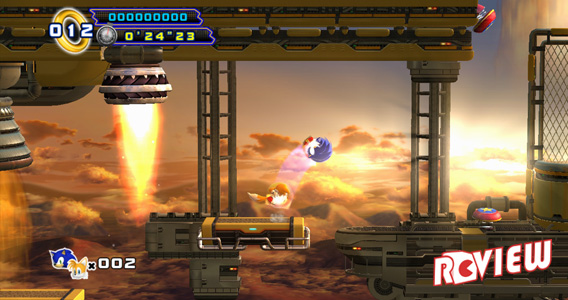
Let’s not beat around the bush; Sonic 4: Episode I was a major disappointment. Despite its build up as Sonic’s triumphant return to form, the game lacked just about everything that made the original Genesis titles fun. The art style was uninspired and had a glossy sheen, the levels and bosses were rehashes of earlier works, and the physics system made the speedy hedgehog handle like a drunk duck.
Fortunately Sega has FINALLY listened to the complaints, and for the first time in more than a decade delivered a Sonic game that fans of all ages should actually enjoy.
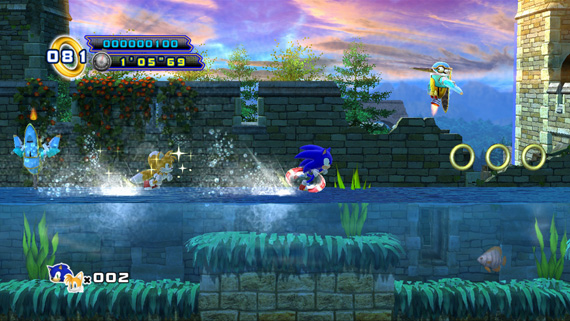
Despite being labeled as the second half of Sonic 4, Episode II is very much a standalone title; both in its lack of connection to Episode I and the fact that the entire engine has been rebuilt from the ground up. Gone is the shiny world of the original in favor of a new lighting system that delivers a more matte appearance. It’s a major change to the visual aesthetic that greatly increases immersion and delivers a more professional look. Sega has also taken the time to improve a number of animations that felt subpar, most notably Sonic’s “floaty” walk cycle. Where before it felt like Sonic was slide-walking on a frictionless surface, it now feels like his feet are firmly planted on the ground.
Speaking of planted feet, by far the biggest improvement to Episode II is the inclusion of a physics engine that understands the laws of videogame dynamics. In short: Spinny thing goes off cliff; Spinny thing keeps moving to the right as it drops. None of the “roll off the edge and drop like a rock of dark matter” garbage that made Episode I feel so awkward. You’ll also find that Sonic gains a significant amount of speed when rolling down hills, not just when running, and generally feels a lot closer to his Genesis version.
Sonic is still a bit slow when starting to run, but it takes significantly less time to get up to speed than it did in the previous episode, and there’s always the jump flip to quickly give you that initial boost. The homing attack, a much maligned staple of the Modern Sonic era, returns, but is primarily used as a means of attack, not platforming. This is possibly the best decision Sega has made as Homing Attack platforming has never been fun and often led to great frustrations.
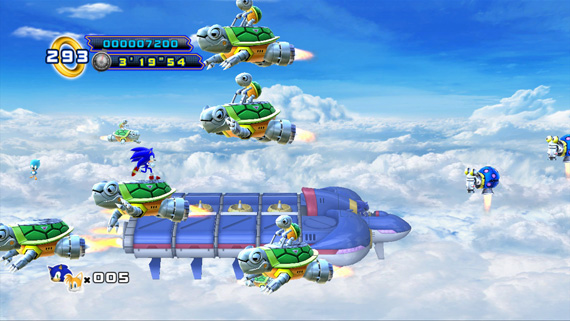
New to Episode II is the inclusion of Miles “Tails” Prower as a companion, and the introduction of Tag Actions. Jump into the air, press the Tag button (X button on X360) and Tails will grab hold of Sonic and carry him into the sky, just like in Sonic 3. It’s incredibly convenient for both exploring and crossing huge gaps, but can be a bit tricky to use as the amount of time you can lift Sonic before Tails starts to tire seems horribly inconsistent.
Sometimes it’s five vertical lifts, other times it’s seven, and still other times it feels like you can fly forever so long as you float for a bit between lifts. It’d be easier to understand if there were some sort of gauge or indicator, but there’s not and you have to do it entirely on feel and luck. In addition to “Fly”, Tails can also use a swimming Tag Action to quickly carry Sonic through underwater segments and “Rolling Combo” to merge with Sonic and form a giant spinning ball of death that bowls through enemies and some walls. Both are incredibly useful and open up new options for platforming.
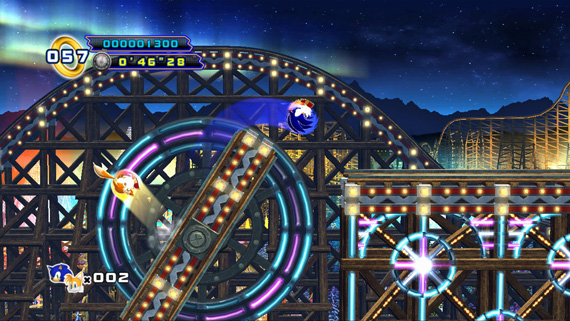
Like its predecessor, Episode II consists of four zones, each containing three acts and one boss fight; and one final zone that features only one of each. However unlike its predecessor these zones are actually new areas and not just rehashes of older material. The only exception is Sky Fortress Zone, which is basically Sky Chase Zone from Sonic 2. While not as large as the zones of Sonic 3, they are by no means small and always offer at least 2-3 different paths of travel.
Hidden within each stage is a Red Ring. While the ring itself does not appear to do anything, it does offer a collection incentive and encourages players to explore, rather than just bolting to the end. To make searching for the ring a little safer Episode II has adopted the warning signs from Sonic Generations, letting you know if the pit you’re about to jump into is safe or will result in instant death. It’s a small addition, but a good one. As per the norm, collecting 50 rings and then crossing the finish post will grant you access to the Special Stages, which play almost identical to the stages from Sonic 2.
Despite doing a number of things right, Episode II is not without its faults, namely the games’ ridiculously slow boss battles. First you have to race through the stage collecting about 50 rings. Then you encounter the boss, who goes into a startup animation that can take upwards of 30 seconds. Then you hit the boss once and he goes into an invincibility state where you may not be able to hit him for some time. Repeat until eight hits are delivered and throw in at least one more long animation after you deliver the seventh blow. In the case of the Oil Desert boss this can become extremely annoying and draw the fight out to well over five minutes. Worse still, you have to replay these animations every time you restart the fight, so if you die you can expect to watch that 30 second startup animation all over again. Most games have enough common sense to skip long animations if you’re going to be seeing them for a second time, but not Episode II. It’s a major point of frustration, especially if the boss is giving you trouble.
In addition to the solid single-player mode, Episode II also brings back co-op play, though its execution leaves much to be desired. Unlike the co-op modes of past, where Sonic was the primary focus and no one really cared if Tails lived or died, Episode II tries to level the playing field by placing an equal focus on both players. The result is, to put it mildly, a mess. The game tries to keep both players on screen by zooming out, but after it gets to a medium range it just teleports one player to the other, often the one that is further ahead, but not necessarily on the correct path. Using tag actions also causes the non-initiating player to be teleported, as does pressing the call button. While this is occasionally useful, for the most part it’s just super awkward. It may be fun for a quick laugh, but unless you’re playing with your exact double I’d recommend avoiding it.
Soncis 4: Episode II is without a doubt the best 2D Sonic game to come out in a decade. Is it perfect? No. But it manages to achieve the proper blend of classic and modern Sonic that no other game, including Sonic Generations, has been able to achieve. If you love the hedgehog it’s definitely worth a playthrough.
Sonic Team, Dimps
Publisher
Sega
System
Xbox 360 (Xbox LIVE Arcade), PlayStation 3 (PlayStation Network), PC, iOS (Xbox LIVE Arcade Reviewed)
Modes
Singleplayer, Co-op
Release Date
May 15, 2012
Price
$14.99 PS3 / PC, 1200 Microsoft Points, $6.99 iOS
*A copy of this title was provided by the publisher for review
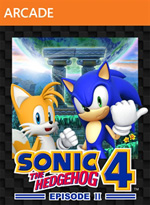
I started playing Episode I after buying it shortly after launch and played for a bit before putting the game back on my “to play” list . Glad to see that some of the small problems have been fixed. Still not sure I’ll jump at Episode II, since that $15 price tag is still too high.
Comment by EdEN — May 22, 2012 @ 11:18 am